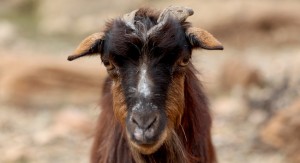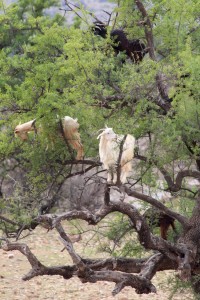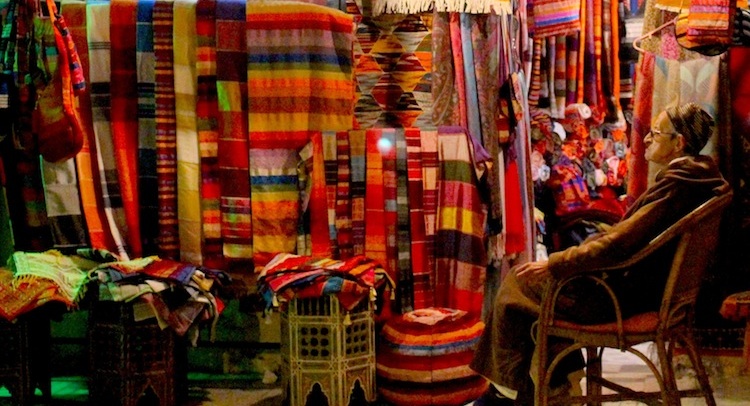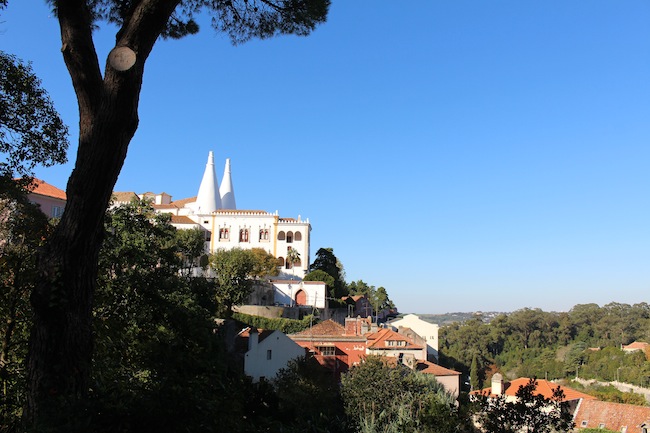We have never been to Morocco – we had lots of ideas of what it might be like, had read many stories, but we didn’t expect what we got…
We had been looking forward to breaking out the tent again after many weeks in the casita and house sitting and had imagined warm winter sun gently caressing Chubby Coleman, our big old tent left long under wraps.
This was the picture in our heads:

The sun sets and seagulls swarm over the Essaouira medina
What we got was torrential rain, lightening and thunder. We stayed two nights at our first camp, thinking it would blow over, then packed up between rain clouds and headed south – to the sun, right? Nope. More days of torrential rain, damp tent and to top it all – two punctured airbeds and a dead computer. Nothing exciting or exotic about any of that! Moulay Bousleham is next to a lagoon, which fills with migrating flamingoes in the spring, unfortunately the lagoon seemed more intent on filling the campsite during our flying visit!

Camp breakfast after it had dried out in Moulay Bouselham

Moulay Bouselham lagoon, with the Atlantic surf on the horizon

The gaint strawberry mosque at Moulay Bouselham
Admittedly, the inexplicable giant strawberry outside the mosque did make us laugh, but even the sheep that were herded past our tent for morning and evening feeds – which we also did not expect to see – seemed unimpressed by the relentless rain.

Sheep are herded through the campsite twice a day

Even the sheep thought the camp at Moulay Bouselham was too muddy
Eventually we managed to catch a break in the rain, packed a soggy Chubby into the car and headed south again.
By the time we got to Rabat, the capital of Morocco, the rain was becoming just a memory and the ancient stones of the Rabat kasbah and necropolis glowed in the sunshine. The blue and white walls and doors of the kasbah are beautiful and worth a visit to the city for that alone.

White, blue and a touch of red, Rabat kasbah

Tiles and pots in Rabat kasbah

The multi-coloured Rabat medina

The kasbah at Rabat

Painted doorway, Rabat kasbah

Cats have it easy in the Rabat kasbah

Hitching a ride

Entrance to a mosque in Rabat kasbah – the sign says Mulims only

Hand made door decor in Rabat kasbah
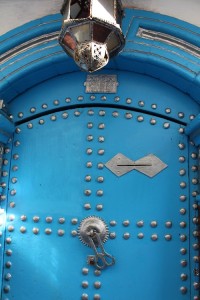
Silver and blue doorway, Rabat kasbah

Rabat kasbah from across the river

Studded door in Rabat kasbah
The ancient necropolis – once a Roman settlement – on the edge of the city is a fascinating place and home to countless clacking storks, but Geoff got a stalk of a different kind – a double dose!
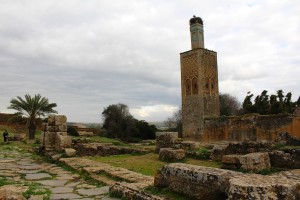
The necropolis at Rabat, complete with storks nest

The remains of beautiful mosiacs can still be seen at the Rabat necropolis
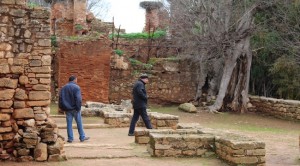
Stalking Geoff – how not to get hired as a guide

Stalking Geoff – it’s okay if you are a cat

Stalking Geoff – The necropolis cat wins!

Green door at the necropolis
The Hassan Tower in the centre of the city is also a sight to see, set as it is amongst more ancient Roman ruins and guarded by elegant horsemen.

The Hassan Tower among the Roman columns in Rabat

Guarding Hassan Tower, Rabat
From Rabat, again we have pushed south, toward Casablanca. Is there any other city that so immediately evokes thoughts of Hollywood glamour and excitement? We turned to fellow travellers on the internet for some insider wisdom on the best places to visit. “Do Not Go To Casablanca” was the overwhelming message from almost every review we read. The only thing worth visiting is the Hassan II mosque. Built only a couple of decades ago, in just six years, to honour the dying King, it is one of the largest mosques in the world. Twenty-five thousand devotees can be housed inside and a further 75,000 outside.

The Hassan II Mosque in Casablanca in the pouring rain

Just a fraction of the massive Hassan II mosque, Casablanca

Massive windows in the distance at the Hassan II mosque, Casablanca
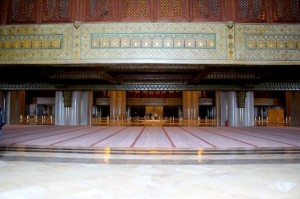
Looking across the width of the Hassan II Mosque, Casablanca, with the women’s balcony above

Geoff at the Hassan II Mosque, Casablanca. King Hassan decreed non-Muslims should be allowed inside

Ceiling decoration and crystal chandeliers in the Hassan II Mosque in Casablanca

Titanium doors on the Hassan II Mosque, Casablanca
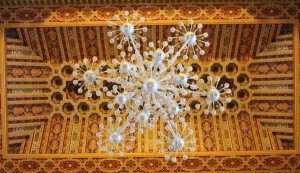
Wooden roof and Venetian crystal chandelier at the Hassan II mosque, Casablanca

The columns are made partly of eggshells to absorb the damp from the hamman below the Hassan II mosque, Casablanca

The yet-to-be used public baths below Hassan II mosque, Casablanca
It is perhaps true that the only thing worth seeing in Casablanca is the Hassan II mosque, if you are a tourist. Its sheer scale is very impressive, but we have seen more beauty in other buildings. Casablanca itself it simply a very large city – not geared for tourism or visuals feasts. Suckered by Hollywood again!
So onward and further south we have pressed, driving for most of the afternoon past donkey carts, sheep and cattle herders, shepherds, farmers and all points in between.

Hard to decide which one looks more composed

Brightly coloured baskets for sale along the road

A splash of colour in the mud

A roadside chat

Lady donkey driver

Leading the way, even though he’s being ignored!

Morocco is marred by endless garbage
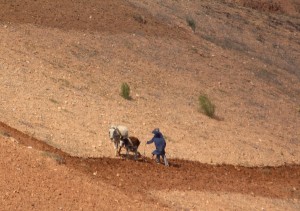
Ploughing the unforgiving landscape

Shepherdess

Striding out with purpose (and bucket)

Tangine top hat

The long day’s journey

The look in his eye says it all… the horse’s eye, that it is!

The sheep herder

Three ladies by the roadside

Two children and a wheelbarrow

Woman in red buggy

A well-earned rest
We landed in Essaouira – a fishing town beloved by surfers in the summer season and a rather chilled and easy place out of season. Those surf-making winds can be rough this time of year though and we had to hang on to Chubby the tent as it was buffeted every which way as we put it up. A tour around town found a wonderful local metal fabricator who, after we had stumbled through our basic French and waved our one remaining tent peg in the air, stopped what he was doing to bend and bang out twelve new heavy-duty pegs on the spot. Chubby is now tight as a drum.

It was no problem for him to stop what he was doing and cut us 12 new tent pegs to battle the Esaouira winds
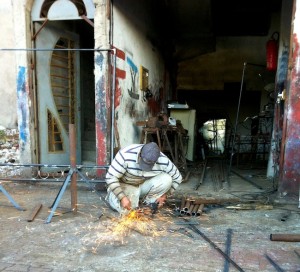
Health and safety be damned – this is how we roll in Morocco!

Made on the spot, with a cheery smile and a 7 euro bill for 12 new pegs
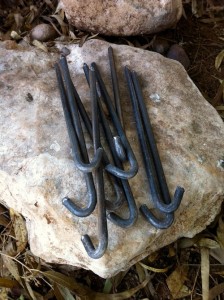
Our brand new, hand-made tent pegs
With Chubby pegged down we were free to explore the sights, smells and colour of the Essaouira medina and port – what a feast for the senses!

Women in Essaouira port

The olive seller in Essaouira medina

The carpet seller in Essaouira medina

The boat and the battlements of Essaouira

The blue boats in Essaouira harbour

Souvenirs for sale at the Essaouira medina

Slippers for sale, Essaouira medina

Pots of dye in Essaouira medina

Night time at the Essaouira medina

Boat builders of Essaouira

Camels on the beach at Essaouira

Lamps and drapes in the Essaouira medina
We are beginning to settle into Moroccan life – and even Moroccan driving!

You name it, they’ll drive it

Overtaking Moroccan style – four at a time

Hay bale hold-up
We hope to spend some weeks in this new country – exploring the deserts and mountains, coasts and oases – we hope you will come along for the ride.











